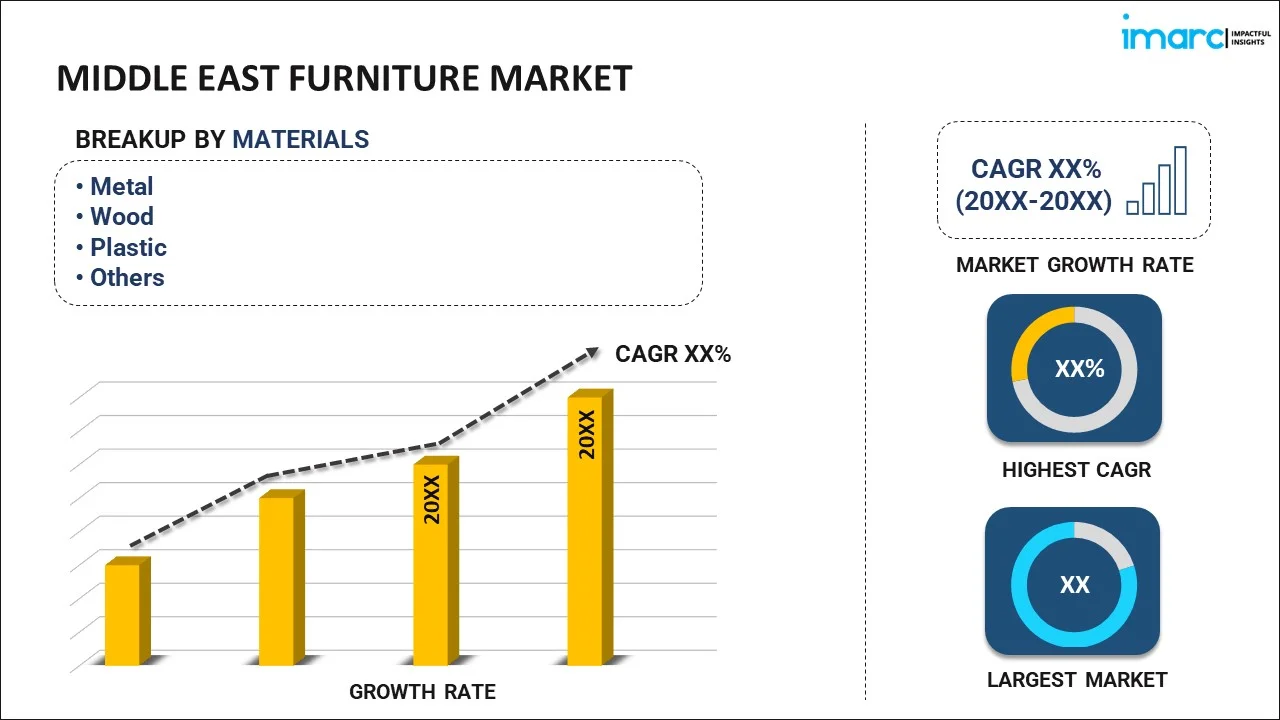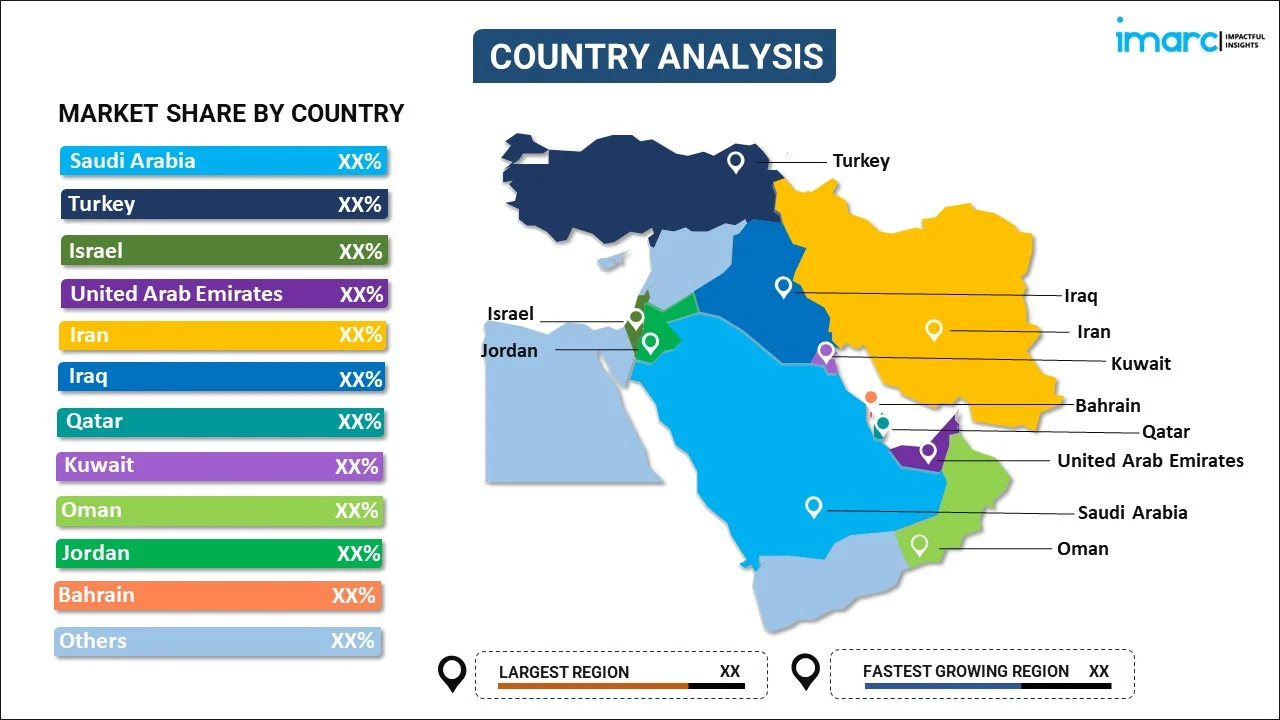
Middle East Furniture Market Report by Material (Metal, Wood, Plastic, Glass, and Others), Distribution Channel (Supermarkets and Hypermarkets, Specialty Stores, Online Stores, and Others), End Use (Residential, Commercial), and Country 2025-2033
Market Overview:
Middle East furniture market size reached USD 29,415 Million in 2024. Looking forward, IMARC Group expects the market to reach USD 42,685 Million by 2033, exhibiting a growth rate (CAGR) of 4.22% during 2025-2033. The rising construction activities, the increasing appeal of tourism, the expansion of the hospitality sector, and the widespread adoption of e-commerce and digitization represent some of the key factors driving the market.
|
Report Attribute
|
Key Statistics
|
|---|---|
|
Base Year
|
2024
|
|
Forecast Years
|
2025-2033
|
|
Historical Years
|
2019-2024
|
|
Market Size in 2024
|
USD 29,415 Million |
|
Market Forecast in 2033
|
USD 42,685 Million |
| Market Growth Rate 2025-2033 | 4.22% |
Furniture pertains to portable objects crafted to facilitate diverse human activities, ranging from sitting and sleeping to storing items. This category encompasses a variety of items, such as chairs, tables, beds, and cabinets, typically crafted from materials like wood, metal, plastic, and upholstery. Furniture serves the purpose of providing comfort, enabling individuals to relax and engage in activities with ease. Additionally, it plays a crucial role in enhancing the visual appeal of a space, contributing to the overall aesthetics and creating an inviting atmosphere. The use of furniture is prevalent in various domestic settings, including living rooms, bedrooms, kitchens, and dining areas, where it serves both functional and decorative purposes.
Middle East Furniture Market Trends:
The Middle East furniture market is experiencing substantial growth, driven primarily by the region's significant urbanization and population expansion. As cities expand and new residential and commercial spaces emerge, there is a notable surge in the demand for furniture. Additionally, the market is further fueled by extensive construction activities, large-scale projects, and ongoing infrastructure developments. Besides this, the rising disposable incomes play a crucial role, empowering consumers with increased purchasing power for furniture and home decor, consequently elevating the demand for premium and luxury furniture products in the region. The expanding hospitality sector, encompassing hotels, resorts, and serviced apartments, is another key contributor to market growth, as these establishments increasingly adopt a wide range of furniture. Furthermore, a discernible shift toward modern and contemporary furniture designs is evident, driven by consumer preferences for sleek, minimalist styles. This shift is notably influenced by the younger population, which tends to gravitate towards international design aesthetics. Environmental considerations also play a role, with consumers expressing a growing interest in eco-friendly and sustainable furniture options. The influence of expanding e-commerce and digital platforms, providing convenient channels for browsing and purchasing furniture online, will add to the positive market outlook across the region in the coming years.
Middle East Furniture Market Segmentation:
IMARC Group provides an analysis of the key trends in each segment of the market, along with forecasts at the regional and country levels for 2025-2033. Our report has categorized the market based on material, distribution channel, and end use.
Material Insights:

- Metal
- Wood
- Plastic
- Glass
- Others
The report has provided a detailed breakup and analysis of the market based on the material. This includes metal, wood, plastic, glass, and others.
Distribution Channel Insights:
- Supermarkets and Hypermarkets
- Specialty Stores
- Online Stores
- Others
A detailed breakup and analysis of the market based on the distribution channel have also been provided in the report. This includes supermarkets and hypermarkets, specialty stores, online stores, and others.
End Use Insights:
- Residential
- Commercial
The report has provided a detailed breakup and analysis of the market based on the end use. This includes residential and commercial.
Country Insights:

- Saudi Arabia
- Turkey
- Israel
- United Arab Emirates
- Iran
- Iraq
- Qatar
- Kuwait
- Oman
- Jordan
- Bahrain
- Others
The report has also provided a comprehensive analysis of all the major regional markets, which include Saudi Arabia, Turkey, Israel, United Arab Emirates, Iran, Iraq, Qatar, Kuwait, Oman, Jordan, Bahrain, and Others.
Competitive Landscape:
The market research report has also provided a comprehensive analysis of the competitive landscape. Competitive analysis such as market structure, key player positioning, top winning strategies, competitive dashboard, and company evaluation quadrant has been covered in the report. Also, detailed profiles of all major companies have been provided. Some of the key players include:
- Al Rugaib Furniture
- Almutlaq Furniture Inc.
- Home Centre
- Inter IKEA Group
- Marina Home
- Pan Home
(Please note that this is only a partial list of the key players, and the complete list is provided in the report.)
Middle East Furniture Market Report Coverage:
| Report Features | Details |
|---|---|
| Base Year of the Analysis | 2024 |
| Historical Period | 2019-2024 |
| Forecast Period | 2025-2033 |
| Units | Million USD |
| Scope of the Report | Exploration of Historical and Forecast Trends, Industry Catalysts and Challenges, Segment-Wise Historical and Predictive Market Assessment:
|
| Materials Covered | Metal, Wood, Plastic, Glass, Others |
| Distribution Channels Covered | Supermarkets and Hypermarkets, Specialty Stores, Online Stores, Others |
| End Uses Covered | Residential, Commercial |
| Countries Covered | Saudi Arabia, Turkey, Israel, United Arab Emirates, Iran, Iraq, Qatar, Kuwait, Oman, Jordan, Bahrain, Others |
| Companies Covered | Al Rugaib Furniture, Almutlaq Furniture Inc., Home Centre, Inter IKEA Group, Marina Home, Pan Home, etc. |
| Customization Scope | 10% Free Customization |
| Post-Sale Analyst Support | 10-12 Weeks |
| Delivery Format | PDF and Excel through Email (We can also provide the editable version of the report in PPT/Word format on special request) |
Key Questions Answered in This Report:
- How has the Middle East furniture market performed so far and how will it perform in the coming years?
- What has been the impact of COVID-19 on the Middle East furniture market?
- What is the breakup of the Middle East furniture market on the basis of material?
- What is the breakup of the Middle East furniture market on the basis of distribution channel?
- What is the breakup of the Middle East furniture market on the basis of end use?
- What are the various stages in the value chain of the Middle East furniture market?
- What are the key driving factors and challenges in the Middle East furniture?
- What is the structure of the Middle East furniture market and who are the key players?
- What is the degree of competition in the Middle East furniture market?
Key Benefits for Stakeholders:
- IMARC’s industry report offers a comprehensive quantitative analysis of various market segments, historical and current market trends, market forecasts, and dynamics of the Middle East furniture market from 2019-2033.
- The research report provides the latest information on the market drivers, challenges, and opportunities in the Middle East furniture market.
- Porter's five forces analysis assist stakeholders in assessing the impact of new entrants, competitive rivalry, supplier power, buyer power, and the threat of substitution. It helps stakeholders to analyze the level of competition within the Middle East furniture industry and its attractiveness.
- Competitive landscape allows stakeholders to understand their competitive environment and provides an insight into the current positions of key players in the market.
Need more help?
- Speak to our experienced analysts for insights on the current market scenarios.
- Include additional segments and countries to customize the report as per your requirement.
- Gain an unparalleled competitive advantage in your domain by understanding how to utilize the report and positively impacting your operations and revenue.
- For further assistance, please connect with our analysts.
 Request Customization
Request Customization
 Speak to an Analyst
Speak to an Analyst
 Request Brochure
Request Brochure
 Inquire Before Buying
Inquire Before Buying




.webp)




.webp)












